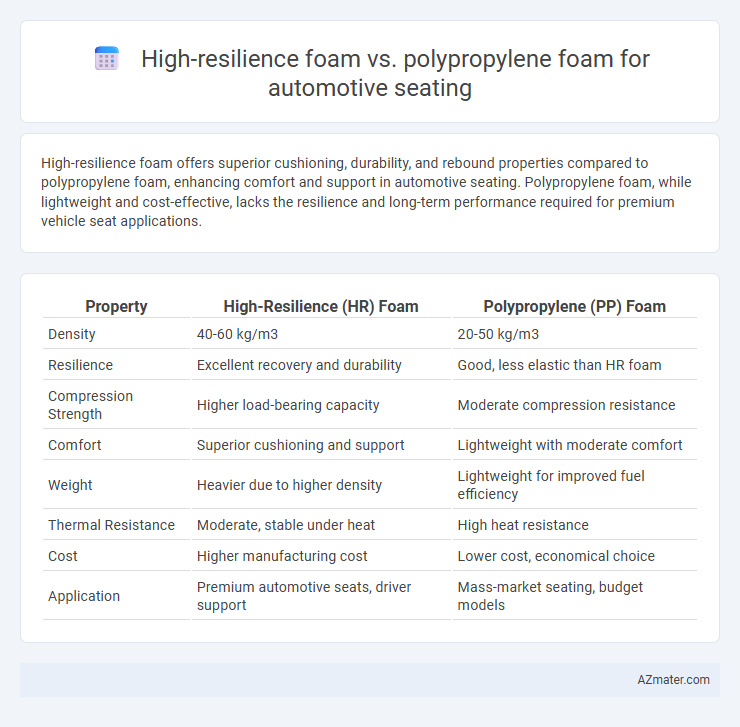High-resilience foam offers superior cushioning, durability, and rebound properties compared to polypropylene foam, enhancing comfort and support in automotive seating. Polypropylene foam, while lightweight and cost-effective, lacks the resilience and long-term performance required for premium vehicle seat applications.
Table of Comparison
| Property | High-Resilience (HR) Foam | Polypropylene (PP) Foam |
|---|---|---|
| Density | 40-60 kg/m3 | 20-50 kg/m3 |
| Resilience | Excellent recovery and durability | Good, less elastic than HR foam |
| Compression Strength | Higher load-bearing capacity | Moderate compression resistance |
| Comfort | Superior cushioning and support | Lightweight with moderate comfort |
| Weight | Heavier due to higher density | Lightweight for improved fuel efficiency |
| Thermal Resistance | Moderate, stable under heat | High heat resistance |
| Cost | Higher manufacturing cost | Lower cost, economical choice |
| Application | Premium automotive seats, driver support | Mass-market seating, budget models |
Introduction to Automotive Seating Foams
High-resilience (HR) foam offers superior cushioning and durability in automotive seating, maintaining comfort and shape over extended periods, crucial for long-term vehicle use. Polypropylene foam provides excellent lightweight properties and impact resistance, enhancing fuel efficiency while ensuring sufficient comfort and structural support. Both foams serve essential roles in automotive interiors, with HR foam excelling in ergonomic performance and polypropylene foam favored for cost-effective weight reduction.
What is High-Resilience Foam?
High-resilience foam is a type of polyurethane foam known for its superior elasticity, durability, and support, making it ideal for automotive seating where comfort and longevity are critical. Unlike polypropylene foam, high-resilience foam offers better pressure distribution and rebound properties, enhancing driver and passenger comfort during long rides. Its open-cell structure ensures breathability and moisture resistance, contributing to a cooler and more hygienic seating experience in vehicles.
What is Polypropylene Foam?
Polypropylene foam is a lightweight, durable polymer foam widely used in automotive seating for its excellent energy absorption and resistance to moisture and chemicals. Its open-cell structure provides good cushioning and thermal insulation, making it ideal for long-term comfort and safety in vehicle seats. Compared to high-resilience foam, polypropylene foam offers superior dimensional stability and recyclability, enhancing overall seat durability and environmental sustainability.
Key Material Properties Comparison
High-resilience foam offers superior elasticity and durability with a higher compression set resistance, enhancing long-term comfort and shape retention in automotive seating compared to polypropylene foam. Polypropylene foam provides excellent chemical resistance and lightweight properties but generally exhibits lower tensile strength and resilience, making it less effective in absorbing repeated impacts. Both materials balance density and cushioning effects differently, where high-resilience foam achieves better energy absorption crucial for occupant support and vibration damping.
Comfort and Support Analysis
High-resilience (HR) foam offers superior comfort and support in automotive seating due to its excellent elasticity and faster recovery time, maintaining seat shape and cushioning over extended use. Polypropylene foam, while lighter and more resistant to moisture and chemicals, generally provides less cushioning and can compress more quickly, reducing long-term comfort. The density and cell structure of HR foam contribute to better pressure distribution and durability, making it a preferred choice for ergonomic vehicle seats prioritizing driver and passenger comfort.
Durability and Lifespan in Automotive Applications
High-resilience (HR) foam offers superior durability compared to polypropylene foam, maintaining its shape and support over extended periods under constant load and frequent use, which is critical for automotive seating comfort and safety. Polypropylene foam, while lightweight and cost-effective, tends to degrade faster, showing signs of compression set and cell collapse that reduce cushioning performance and lifespan. In automotive applications, HR foam delivers enhanced resilience and longevity, reducing the need for frequent seat replacements and ensuring consistent occupant support.
Weight and Fuel Efficiency Considerations
High-resilience foam offers superior cushioning with a slightly higher density compared to polypropylene foam, resulting in a modest increase in seat weight. Polypropylene foam's lightweight properties contribute to overall vehicle weight reduction, enhancing fuel efficiency by lowering energy consumption during operation. Selecting polypropylene foam for automotive seating can optimize fuel economy, while high-resilience foam provides enhanced comfort at a minimal weight penalty.
Manufacturing and Cost Factors
High-resilience foam offers superior durability and comfort in automotive seating through its open-cell structure and high load-bearing capacity, but manufacturing costs are higher due to complex processing and raw material expenses. Polypropylene foam is cost-effective with easier molding and lower material costs, enabling faster production cycles suitable for budget vehicles. Manufacturing decisions balance resilience and cushioning performance against cost efficiency, influencing automotive seating design and market positioning.
Sustainability and Environmental Impact
High-resilience foam, known for its durability and prolonged lifecycle, reduces the frequency of seat replacement, thereby lowering waste generation in automotive seating applications. Polypropylene foam, being a thermoplastic, offers enhanced recyclability and is often produced using less energy-intensive processes, contributing to a smaller carbon footprint. Choosing between these materials involves balancing long-term durability benefits of high-resilience foam against the recyclable and energy-efficient characteristics of polypropylene foam for more sustainable automotive seating solutions.
Conclusion: Choosing the Best Foam for Automotive Seating
High-resilience foam offers superior comfort and durability due to its excellent elasticity and long-term shape retention, making it ideal for premium automotive seating applications. Polypropylene foam provides lightweight and cost-effective cushioning with good impact absorption but may lack the resilience needed for extended use in high-stress seating environments. Selecting the best foam depends on prioritizing either enhanced comfort and longevity with high-resilience foam or cost efficiency and weight reduction with polypropylene foam for automotive seats.

Infographic: High-resilience foam vs Polypropylene foam for Automotive seating
 azmater.com
azmater.com